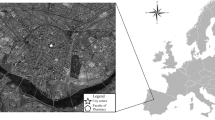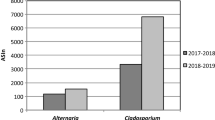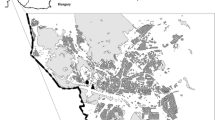Abstract
Airborne Alternaria spore presence depends in part on temperature and most studies claim that the highest values are found in summer. Such pattern, however, does not match in Mediterranean countries. The aim of present work is to study the pattern of airborne Alternaria in three places in the SW of Spain and to study the influence of meteorological factor in each station. Data of airborne spore concentration for a total of five different years study period, in three cities in the SW of Spain—Badajoz, Cáceres and Mérida—are provided in the present work. Continuous sampling was carried out using a Hirst volumetric spore trap in each location. Results were analyzed taking into account weather parameters regarding temperature, rain and relative humidity. Average concentration accounting for the complete data set (i.e. considering three locations and full time period) approached 50 spores/m3. Although Alternaria spores are present nearly throughout the whole year, monthly data showed that on three occasions October was the month with the highest monthly concentrations—up to 342 spores/m3, and January and February those with the lowest concentrations—when even no spores were recorded. Daily data showed a concentration peak of 1,380 spores/m3 in Mérida in October. Annual spore concentration showed a pronounced seasonality, with a first maximum concentration in autumn, mainly in October, and a second peak in spring, mainly in May and June. A clear drop was observed in summer, but values remained around the annual average concentration. Data of spore concentration showed statistically significant positive correlation with temperature and statistically significant negative correlation with rain and relative humidity. Monthly concentration of Alternaria spores was positively affected by temperature and negatively affected by relative humidity and rain; nevertheless, the decrease of relative humidity below 55% showed a drop in spore concentration regardless of any increase in temperature.






Similar content being viewed by others
References
Angulo, J., Mediavilla, A., & Domínguez, E. (1999). Conidia of Alternaria in the atmosphere of the city of Cordoba, Spain in relation to meteorological parameters. International Journal of Biometeorology, 43, 45–49.
Bashan, Y., Levanony, H., & Or, R. (1991). Wind dispersal of Alternaria alternata, a cause of leaf blight of cotton. Journal of Phytopathology, 133, 225–238.
Bass, D., & Morgan, G. (1997). A three year (1993–1995) calendar of pollen and Alternaria mould in the atmosphere of south western Sydney. Grana, 36, 293–300.
Bush, R. K., & Prochnau, J. J. (2004). Alternaria-induced asthma. The Journal of Allergy and Clinical Immunology, 113, 227–234.
Corden, J. M., Millington, W. M., & Mullins, J. (2003). Long-term trends and regional variation in the aeroallergen Alternaria in Cardiff and Derby UK—are differences in climate and cereal production having an effect? Aerobiologia, 19, 191–199.
Cosentino, S., Fadda, M. E., & Palmas, F. (1995). Pollen and mould allergy in Southern Sardinia (Italy): comparison of skin-test frequencies and air sampling data. Grana, 34, 338–344.
De Linares, C., Belmonte, J., Canela, M., de la Guardia, C. D., Alba-Sánchez, F., Sabariego, S., et al. (2010). Dispersal patterns of Alternaria conidia in Spain. Agricultural and Forest Meteorology, 150, 1491–1500.
Durham, O. C. (1938). Incidence of air-borne fungus spores: II. Hormodendrum, Alternaria, and rust spores. Journal of Allergy, 10, 40–49.
Durham, O. C. (1944). The volumetric incidence of atmospheric allergens: II. Simultaneous measurements by volumetric and gravity slide methods. Results with ragweed pollen and Alternaria spores. Journal of Allergy, 15, 226–235.
Escuredo, O., Seijo, M. C., Fernández-González, M., & Iglesias, I. (2011). Effects of meteorological factors on the levels of Alternaria spores on a potato crop. International Journal of Biometeorology, 55, 243–252.
Gravesen, S. (1979). Fungi as a cause of allergic disease. Allergy, 34, 135–154.
Grinn-Gofroń, A., & Rapiejko, P. (2009). Occurrence of Cladosporium spp. and Alternaria spp. spores in Western, Northern and Central-Eastern Poland in 2004–2006 and relation to some meteorological factors. Atmospheric Research, 93, 747–758.
Grinn-Gofron, A., & Strzelczak, A. (2008). Artificial neural network models of relationships between Alternaria spores and meteorological factors in Szczecin (Poland). International Journal of Biometeorology, 52, 859–868.
Herrero, B., & Zaldívar, P. (1997). Effects of meteorological factors on the levels of Alternaria and Cladosporium spores in the atmosphere of Palencia, 1990–92. Grana, 36, 180–184.
Hill, S. N., & Hausbeck, M. K. (2009). Factors influencing airborne conidial concentrations of Alternaria panax in cultivated American ginseng gardens. Plant Disease, 93(12), 1311–1316.
Hirst, J. M. (1952). An automatic volumetric spore trap. Annals of Applied Biology, 39, 257–265.
Hjelmroos, M. (1993). Relationship between airborne fungal spore presence and weather variables: Cladosporium and Alternaria. Grana, 32, 40–47.
Hyde, H. A., & Williams, D. A. (1946). A daily census of Alternaria spores caught from the atmosphere at Cardiff in 1942 and 1943. Transactions of British Mycological Society, 29, 78–85.
Iglesias, I., Rodríguez-Rajo, F. J., & Méndez, J. (2007). Evaluation of the different Alternaria prediction models on a potato crop in A Limia (NW of Spain). Aerobiologia, 23, 27–34.
Kilic, M., Altintas, F. U., Yilmaz, M., Kendirli, S. G., Karakoc, G. B., Taskin, E., et al. (2010). The effects of meteorological factors and Alternaria spore concentrations on children sensitised to Alternaria. Allergologia et Immunopathologia, 38, 122–128.
Konopinska, A. (2004). Monitoring of Alternaria Ness and Cladosporium Link airborne spores in Lublin (Poland) in 2002. Annals of Agricultural and Environmental Medicine, 11, 47–349.
Langenberg, W. J., Sutton, J. C., & Gillespie, T. J. (1977). Relation of weather variables and production of airborne spores of Alternaria dauci. Phytopathology, 67, 879–883.
Mitakakis, T. Z., Clift, A., & McGee, P. A. (2001). The effect of local cropping activities and weather on the airborne concentration of allergenic Alternaria spores in rural Australia. Grana, 40, 230–239.
Mitakakis, T. Z., & McGee, P. A. (2000). Reliability of measures of spores of Alternaria and pollen concentrations in air over two towns in rural Australia. Grana, 39, 141–145.
Mitakakis, T. Z., Ong, E. K., Stevens, A., Guest, D., & Knox, R. B. (1997). Incidence of Cladosporium, Alternaria and total fungal spores in the atmosphere of Melbourne (Australia) over three years. Aerobiologia, 13, 83–90.
Munuera, M., Carrión, J. S., & Navarro, C. (2001). Airborne Alternaria spores in SE Spain (1993–98). Grana, 40, 111–118.
Nogales, M. T., Domínguez, E., Galán, C., & Ruiz de Clavijo, E. (1986). Variación estacional del contenido en esporas del género Alternaria Nees ex Fr. en el aire de la ciudad de Córdoba (España). Allergology et Immunopathology, 14, 115–119.
Paredes, M. M., Martínez, J. F., Tormo, R., Silva, I., & Muñoz, A. (1997). Influencia de los parámetros meteorológicos en la dispersión de esporas de las especies de Alternaria Nees ex Fr. Boletín de Sanidad Vegetal-Plagas, 23, 541–549.
Peternel, R., Culig, J., & Hrga, I. (2004). Atmospheric concentrations of Cladosporium spp. and Alternaria spp. spores in Zagreg (Croatia) and effects of some meteorological factors. Annals of Agricultural and Environmental Medicine, 11, 303–307.
Rodríguez-Rajo, F. J., Iglesias, I., & Jato, V. (2005). Variation assessment of airborne Alternaria and Cladosporium spores at different bioclimatical conditions. Mycological Research, 109, 497–507.
Rooks, R., Shapiro, R. S., & Horman, E. C. (1960). The incidence of airborne Hormodendrum and Alternaria spores as determined by a volumetric sampler. Journal of Allergy, 31, 97–105.
Sabariego, S., Díaz de la Guardia, C., & Alba, F. (2004). Estudio aerobiológico de los conidios de Alternaria y Cladosporium en la atmósfera de la ciudad de Almería (SE de España). Revista Iberoamericana de Micología, 21, 121–127.
SAGE. (2002). The Atlas of the biosphere is a product of the center for sustainability and the global environment (SAGE). Nelson Institute for Environmental Studies at the University of Wisconsin, Madison. http://www.sage.wisc.edu/atlas/maps/avgannrh/atl_avgannrh_eur.jpg.
Simmons, E. G. (2007). Alternaria—an identification manual. CBS Biodiversity Series, 6, 1–775.
Srivastava, A. K., & Wadhvvani, K. (1992). Dispersion and allergenic manifestations of Alternaria airspora. Grana, 31, 61–66.
Stennett, P. J., & Beggs, P. J. (2004). Alternaria spores in the atmosphere of Sydney, Australia, and relationships with meteorological factors. International Journal of Biometeorology, 49, 98–105.
Stępalska, D., Harmata, K., Kasprzyk, I., Myszkowska, D., & Stach, A. (1999). Occurrence of airborne Cladosporium and Alternaria spores in Southern and Central Poland in 1995–1996. Aerobiologia, 15, 39–47.
Stępalska, D., & Wołek, J. (2009). Intradiurnal periodicity of fungal spore concentrations (Alternaria, Botrytis, Cladosporium, Didymella, Ganoderma) in Cracow, Poland. Aerobiologia, 25, 333–340.
Timmer, L. W., Darhower, H. M., Zitko, S. E., Peever, T. L., Ibáñez, A. M., & Bushong, P. M. (2000). Environmental factors affecting the severity of Alternaria brown spot of citrus and their potential use in timing fungicide applications. Plant Disease, 84, 638–643.
Timmer, L. W., Solel, Z., Gottwald, T. R., Ibañez, A. M., & Zitko, S. E. (1998). Environmental factors affecting production, release, and field populations of conidia of Alternaria alternata, the cause of brown spot of citrus. Phytopathology, 88, 1218–1223.
Tomassetti, B., Bruno, A. A., Pace, L., Verdecchia, M., & Visconti, G. (2009). Prediction of Alternaria and Pleospora concentrations from the meteorological forecast and artificial neural network in L’Aquila, Abruzzo (Central Italy). Aerobiologia, 25, 127–136.
Acknowledgments
The authors wish to thank the Regional Government, Junta de Extremadura (Spain), and the European Regional Development Fund for financial aid through the Projects PRI06A190 and PRIBS10008 by European Social Fund.
Author information
Authors and Affiliations
Corresponding author
Rights and permissions
About this article
Cite this article
Maya-Manzano, J.M., Fernández-Rodríguez, S., Hernández-Trejo, F. et al. Seasonal Mediterranean pattern for airborne spores of Alternaria . Aerobiologia 28, 515–525 (2012). https://doi.org/10.1007/s10453-012-9253-3
Received:
Accepted:
Published:
Issue Date:
DOI: https://doi.org/10.1007/s10453-012-9253-3




